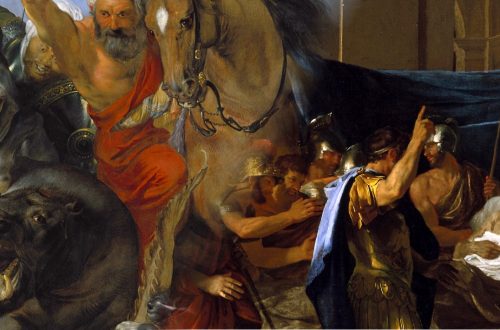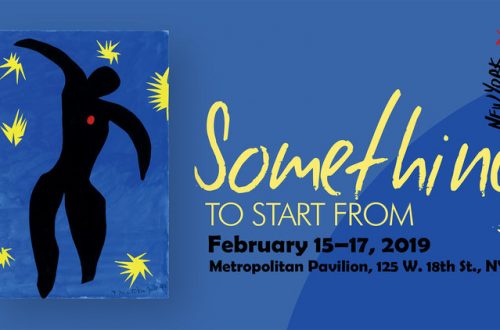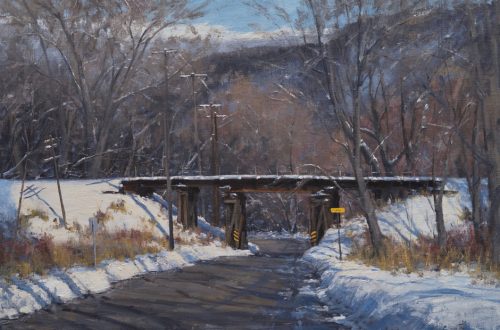by Andrew Carr
On November 6th I went to the museum in the morning, just after it opened. I had stayed up during the night to hear the election results come in.
When I got there, I first went to a small dark room where the museum exhibits a rotating selection of their prints. These are pieces on paper and sensitive to light. They can only be displayed sparingly to avoid damaging them. I went there because I knew they had four prints on display from Francisco Goya’s posthumous series The Proverbs. Each of these images can be mapped in a few words:
- In the first, a woman is thrown like a rag-doll from a rearing horse, which cranes its neck to bite at her stomach, while in the distance lethargic, wide-eyed monsters suck and chew upon another woman’s body.
- In the second a grinning, white-eyed giant, arms wide and playing the castanets, flanked by howling faces, descends upon a man who cowers behind a robed figure, clinging to its rigid form like a child.
- In the third an elderly group, wrapped up and huddled together on a dark branch above a minuscule moon, follow the gestures of a hooded speaker perched among them.
- In the fourth, a couple ride off into a black sky, atop a moth-winged horse, who turns its beaked and feathery face to smile back at the riders, and at us.
Taken together, these scenes built upon one another, accumulating nuance and impact. Each tableau seemed to emerge from the same world, to approach the viewer in turn from out of the same darkness. What were the terms of this world? Concealment, deception, betrayal, paranoia, violence, idiocy, fear, frenzy, power.
Standing there, I could imagine how these words and images might be called on to illustrate the political moment. But I didn’t feel motivated to trace those connections.
I had thought that in the wake of the election Goya would provide a certain painful, clear-eyed honesty about the nature of society. The very bitterness of his images seemed to guarantee their validity. I’m sometimes tempted to believe that the ugliest vision of things must be true— precisely because it is ugly. That only the cruelest interpretation is honest. That a perspective’s ruthlessness is evidence of its authenticity. On that Wednesday I felt particularly receptive to this way of thinking.
But the images turned out to be too much for me. Too sinister, too bitter, too ironic. Even in a small, quiet, and gently lit room, these little pieces made one feel exposed. The scenes were like something seen in an empty lot, by the headlights of a parked car. I couldn’t remain inside their world. Not simply because I couldn’t withstand it—that was true enough—but also because at some level I didn’t believe it. Or rather, these dark vignettes accommodated only part of what I believed. So I went to look for something else.
I stopped next at a Monet I’d never seen, Chrysanthemums. A big oil painting in a thick gold frame, buzzing with pink, orange, yellow, and green. It was hard to imagine anything further from the world of Goya’s proverbs. The painting came from the period after Monet’s celebrated haystacks but before the Giverny waterlilies that would provide unending material for his later career. Writing about those waterlily paintings in a letter to his friend and biographer Gustave Geffroy, Monet described the encompassing effect he hoped that body of work would offer:
…Nerves strained by work would relax in its presence, following the reposing example of its stagnant waters, and for him who would live in it, this room would offer an asylum of peaceful meditation in the midst of a flowering aquarium.
This world of rest appealed to a very different side of my mind that morning. If Goya offered a confrontation with brutal truth, Monet’s letter offered the protection of a private reverie.
And intimations of this asylum he describes seemed already present in Chrysanthemums. Here too was a painting that tried to hold the turmoil of the world at bay, to create a space to breathe. And this levee constructed against the tides of social strain and anxiety was built with exuberant blossoms, packed from floor to ceiling. Here the cavernous night of The Proverbs was held in check by a wall of flowers. The darkness from which Goya’s grotesques emerged was replaced by a bright, even light. The enigmatic gestures and frightening ambiguity gave way to a guileless pattern of scattered chrysanthemums.
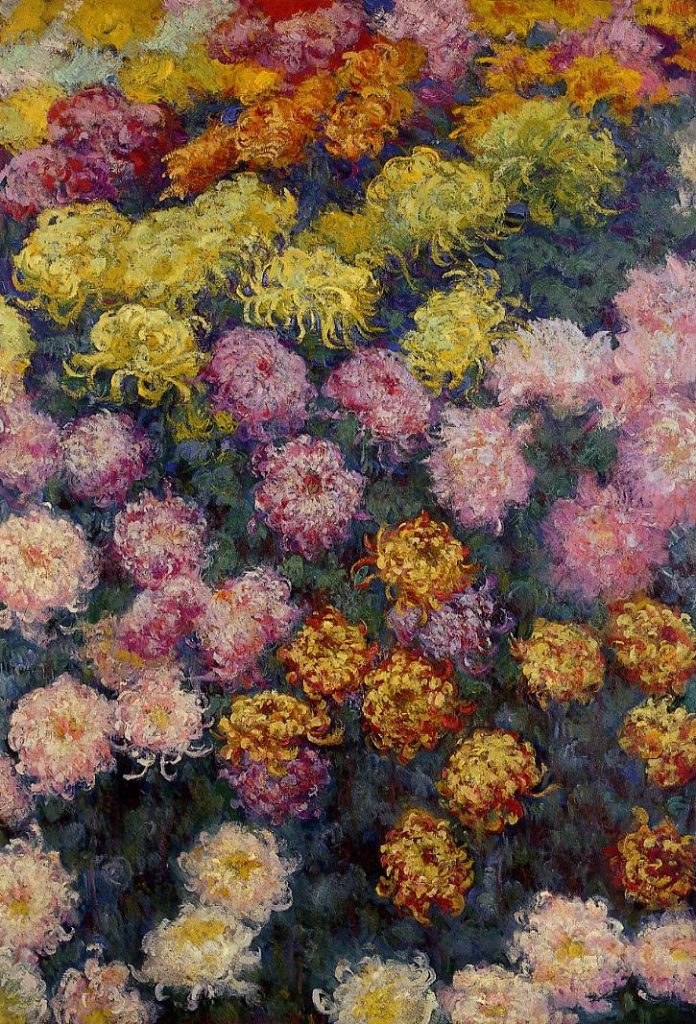
And yet the refuge felt somehow unconvincing, even brittle. The blossoms crowded the viewer out too, leaving little space in which to settle. This had, in part, to do with the intensity of the colors. They were so emphatic, like bright pieces of tissue paper stuffed into a gift bag.
I used to teach art at a small private high school. And one year they designed a school mug to give to parents and donors. On one side of the mug was a painting by Gustave Klimt. It showed a wooden crucifix along a forest path, overgrown with flowers of orange and gold. Next to the image was a quote from Dostoyevski’s The Idiot: “Beauty will save the world.”
That morning after the election, I looked at the Monet and remembered the mug and I thought, “Bullshit.” If the Goyas left me too exposed, the Monet felt too insulated. The works almost felt like refutations of each other. To fully enter either of these visions would have meant leaving behind or ignoring some substantial part of my own internal world. And this was precisely what I did not want to do. I could see how, in their own way, each offered an appropriate response to the moment. And yet neither provided what I was hoping to find.
What was I hoping to find?
From the Monet I wandered into the tall room where the museum has arranged a huge variety of portraits, in all different styles and modes. A luminous self-portrait by William Orpen, the artist with palette and brushes, in a plush white robe, a white kerchief around his head. An Andrew Wyeth of Christina Olson sitting in a dark dress, in the light of an open doorway. Christy White, by Alice Neel, cautious and discerning, seated by the window, in an orange shirt and a half-painted chair. I was, I realized, hoping for something like my own portrait, a portrait of myself as I was on that particular morning.
This process of testing myself in front of different pieces wasn’t just a matter of finding an image to fit my mood—the way you might scroll through a streaming service at the end of the day, hoping to find something that will scratch your particular itch. It was a process of clarification, of clarifying what I really thought and felt. In testing my own frame of mind against the framing of these artworks, I was distinguishing between what I was really experiencing and what I thought I should be experiencing, or saw others experiencing around me. The art was helping me disentangle these threads. And as I set aside or qualified certain reactions—which I could recognize as valid but could not recognize as my own—I was approaching a less mediated, if less immediately legible, sense of my own mind.
There are many times when I go to the museum hoping to find myself in this way, only to leave tired and discouraged. Maybe most of the time. But this time I was lucky. This time I found a rich and vivid landscape printed on three large pieces of paper, framed in white. Set in a row, so that the frames touched, the scene continued uninterrupted from one photo to the next. They were photos of an olive orchard, hanging on a soft blue wall. With these photos came at last a kind of recognition.
The faint green of the olive leaves, dusty and intermingled with their white undersides, was like the central note of that recognition. That blended color reminded me of a favorite shirt that I had at home, thick but soft, white with thin green stripes, which mixed together when seen from across a room, into something like the slightly altered, slightly green-tinted color of a white wall seen reflected in a mirror. Or the color at the bottom of a bathtub full of hot water.
But why did my mind reach for such strange images in trying to name this color: a white wall in a mirror, a white tub filled with water? I think because they pointed towards the other central note that sounded in these three photos. Like smudges on a mirror, or steam in a bathroom, an enigmatic blurriness moved through them. It was the way that the photos were focused. Both between and within each one the focus was variable and unpredictable in a way that the eye had trouble accounting for. Your expectations were continually upset. In one corner the foreground stood out crisp and clear, in the other it dissolved away almost entirely. Some element in the distance, a single grove on the diffuse hillside, suddenly stepped into striking clarity without explanation. Even individual limbs on the same olive tree, twisted in and out of apprehension inexplicably.
Trying to understand the focus in these photos was not unlike the experience of trying to follow the perspective of a cubist painting—where the receding lines in one part of the composition set up expectations for a system of perspective throughout, only to have those expectations explicitly contradicted by neighboring forms. The eye could light on particulars, but struggled for a unified vision.
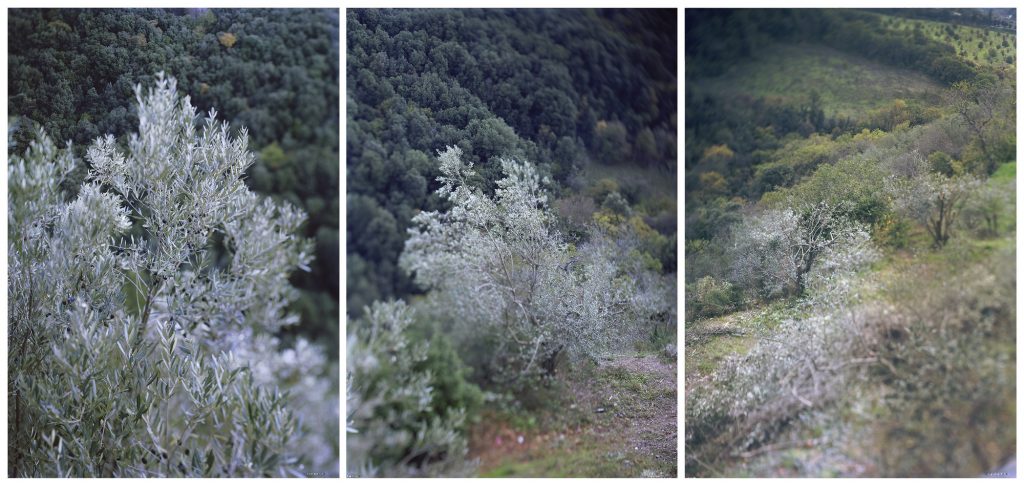
I learned later that the artist, JoAnn Verburg, shot these photos with a view camera, allowing her to tilt the angle between the lens and film, and throw the plane of focus out of parallel with the picture plane. Focus could then run into and out of the image, instead across it, as expected. The effect was perplexing within a single photo, and confounding over three, each with its own tilt. Yet these various focal crosssections added up to a somehow richer awareness of the landscape’s spatial relationships than any one of them could have provided. It recalled the deep spatial awareness accumulated from looking out a car window and watching all the various distances, like backdrops in a theater, passing by at different speeds.
And this struggle within the eye recalled something else too. Many of Verburg’s photos were shot in what seemed like a direct morning light. So that the unexpected pattern of vivid and blurry reminded me of waking up. Of the way that the eye and the mind take time to reacquaint themselves with the world after a night of sleep. Verburg’s uneven focus recalled the re-calibration that comes each morning, both the freshness and the awkwardness of that reawakened eye.
Along with the photos in Verburg’s exhibit, were a number of portraits, shot in video, and extending in a similar way over several adjacent screens. Each of these provided a prolonged and intimate vision of rest:
- In the 6 screens that made up The Poet and the Birds a man lays along the bank of a shimmering river, turned away from us, his head resting at the foot of a willow tree whose leaves fill the upper panels.
- In Daniella (at the Headwaters) a woman watches particles of seed and dust drift in slow procession across the panel above her, as if calmly observing the natural progression of her own thoughts.
- In Listen (Nyla with earbuds) a woman lies on her back playing with the cord to her headphones, while dappled light flickers, like the unheard music, in the grass about her head and on the roots of a nearby tree trunk.
It’s restful to watch others rest. And about the gallery were chairs where one could sit and sink into the work. Like the photos, each screen had its own autonomous focus, and some of the same visual ambiguity was at play. But you were offered rest in the midst of that blurriness, within that ambiguity. And the fact that these were videos and not still images seemed essential to their unique invitation.
Yet they were still images. Movement is video’s particular subject, its unique talent. It records the flight of a bird across the sky, the motions of a cyclist on a hillside, the changing expressions on a face. But here video was put to a very different purpose. Here both camera and subject stayed. The light flickered, on the grass and in the water. The leaves shifted in the breeze, the stream drifted past. But these were the motions of stillness, evidence only that time was passing. In all that stillness, the steady movement of time became apparent, and one’s attention settled into it. This passage of time was reassuring. The knowledge that these individuals really stopped and stayed, not just for an instant but for a time, offered you an ongoing company if you chose to do the same.
I settled into one of the chairs. Other people drifted in and out. I wondered if the videos played all night, when the museum was closed. If they had been playing last night as the votes came in. I opened my notebook and began to write. By the time I was ready to leave, I still had no definite thesis nailed down, no absolute explanation of my feelings. I was still looking for a portrait of myself. But I was thankful for the unique partnership that art offers in that search.

Andrew Grum Carr is an artist, writer, and teacher from St. Paul MN. He writes short fiction and works in watercolor. He loves cinema, the library, and Saturday night jazz. You can find his artwork at www.andrewgrumcarr.com or follow him on Instagram @andrewgrumcarr.
Have you been meaning to sign up for the quote of the day? Click here now to subscribe to “A Daily Dose of Veritas” and receive three quotes a week in your inbox.
Memory, like fire, is radiant and immutable while history serves only those who seek to control it, those who douse the flame of memory in order to put out the dangerous fire of truth. Beware these men for they are dangerous themselves and unwise.
— Albert Hosteen in “The Blessing Way,” The X-Files (Season 3, Episode 1)
header image: Christina Olson, 1947, Andrew Wyeth, American, 1917–2009, tempera on hardboard panel, 33 x 25 in., Myron Kunin Collection of American Art, Minneapolis, Minnesota, © 2017 Andrew Wyeth / Artist Rights Society (ARS), used in keeping with fair use doctrine. All other images are in the public domain or used in keeping with fair use.

